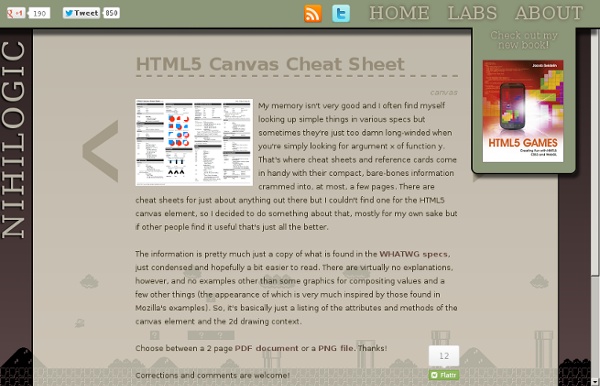How to Make All Browsers Render HTML5 Mark-up Correctly - Even IE6
HTML 5 provides some great new features for web designers who want to code readable, semantically-meaningful layouts. However, support for HTML 5 is still evolving, and Internet Explorer is the last to add support. In this tutorial, we'll create a common layout using some of HTML 5's new semantic elements, then use JavaScript and CSS to make our design backwards-compatible with Internet Explorer.
DJDESIGNERLAB - Find All Your Design Inspirations From This Laboratory
Cheat Sheets are so useful for web-developers to remember various things. It’s always complicated to memorize syntax for web developers and designers since they are always evolving and rising. Here, Cheat Sheet is always come in handy.
How to hide, show, or toggle your div
Are you trying to find a way to hide and show your content? The demo below shows a simple yet elegant way of toggling your content and toggling the control text via Javascript and styling. We will cover how to implement this example later on in the tutorial but first let's start with a simple example. Here is the sample HTML and Javascript code: By default, the peek-a-boo text is loaded when the page loads but the display attribute for the div that the content resides in is set to none so it is not visible to the visitor.
Coding a CSS3 & HTML5 One-Page Website Template
Web development is an area in which you have to keep up with the latest technologies and techniques, so that you are at the top of your game. And no wonder - this is an area which changes with an amazing pace. What is the standard now will be obsolete in just a couple of years.
Mega Collection Of Cheatsheets for Designers And Developers
Cheatsheets and various quick reference guides are available for almost any type of software and language these days. Unfortunately they’re not always easy to find when you actually need them. This is why I decided to take some time to gather up as many as possible and share them with you here! Hopefully this can be a timesaver for you, along with teaching you a new trick or two. The resources have been divided into various categories to make them easier to find.
Tabbed Navigation Using CSS
Introduction The contents of this tutorial – including the images, HTML, JavaScript and CSS – is licensed under an MIT license and is therefore free for you to use. Attribution is appreciated, but not required.
Have a Field Day with HTML5 Forms
Forms are usually seen as that obnoxious thing we have to markup and style. I respectfully disagree: forms (on a par with tables) are the most exciting thing we have to work with. Here we’re going to take a look at how to style a beautiful HTML5 form using some advanced CSS and latest CSS3 techniques. I promise you will want to style your own forms after you’ve read this article.
How to Use jQuery to Make Slick Page Transitions
Adding the final touches to a site can be the difference between a polished and beautiful site that looks “refined,” and a mediocre site that leaves no impression on visitors. jQuery, the versatile JavaScript library, can be leveraged to create all these fine tuned elements. Today we’re going to look at how to use it to create elegant page transitions. Let’s get to it! If you would like to quickly take a peek at a very simple implementation of this technique, below is the demo for viewing and download.
Coding An HTML 5 Layout From Scratch
HTML5 and CSS3 have just arrived (kinda), and with them a whole new battle for the ‘best markup’ trophy has begun. Truth to be told, all these technologies are mere tools waiting for a skilled developer to work on the right project. As developers we shouldn’t get into pointless discussions of which markup is the best. They all lead to nowhere. Rather, we must get a brand new ideology and modify our coding habits to keep the web accessible.
Ideal line length for content
Date: 3 May 2003 Author: Russ Weakley Is there an ideal line length for content? To quote a passage from “Web Style Guide – Basic design principles for creating web sites”. The ideal line length for text layout is based on the physiology of the human eye… At normal reading distance the arc of the visual field is only a few inches – about the width of a well-designed column of text, or about 12 words per line. Research shows that reading slows and retention rates fall as line length begins to exceed the ideal width, because the reader then needs to use the muscles of the eye and neck to track from the end of one line to the beginning of the next line.
Developing Streamlined and Efficient CSS Styles
CSS can be compared to the sculptor’s tool set when crafting a sculpture. We as web designers utilize all the assets CSS brings forth to create structured layouts for our websites. Over the years this design process has become more organized and fitted. Rules have been put in place for best-practice procedures when coding. We’ll have a look at some ideas you can apply to your stylesheets to help speed up your code in future projects. Efficient CSS is easy to manage and easy to read while also supplying a resource to the web designer.



